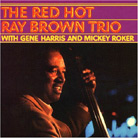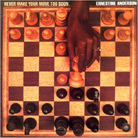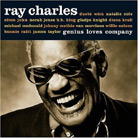![[SoundStage!]](../sslogo3.gif) The Vinyl Word The Vinyl WordBack Issue Article |
May 2006 Found on Vinyl: Ray Brown, Ernestine Anderson, and Ray Charles Ray Brown and Ray Charles were consummate professionals. I seriously doubt that you can find too many recordings either had a hand in that cannot be counted among the best of their genres. Both played with many of the big names of the music profession. Brown’s big, warm tone and impeccable sense of timing are instantly identifiable, and Charles’s voice is equally hard to miss. Their deaths were among the low lights of the past few years. When Ying Tan of Groove Note Records was casting about for recordings in the vast Concord Records archives to reissue, he knew he’d found the right spot in which to dip his line when his thoughts fell to Ray Brown’s contributions. Whether acting as the leader, as in The Red Hot Ray Brown Trio [Groove Note GRV1028-1], or as chief sideman, as on Ernestine Anderson’s Never Make Your Move Too Soon [Groove Note GRV1029-1], Brown’s inclusion ensures top performances. And jazz just don’t get no better than these two recordings.
The Red Hot Ray Brown Trio is the record to put on to initiate the novice to what jazz is all about. It also illustrates why the bass/piano/drum trio setup is the perfect jazz vehicle, and it acts as an introduction to Ray Brown's music. No one swung quite like Brown -- with the possible exception of his pianist on this date, Gene Harris. When these two masters of funky/bluesy/swinging jazz were paired together, sparks flew. The drummer tended to be a bit overshadowed, which may explain why Brown used his drummers so interchangeably. It's not that their presence wasn’t necessary; actually, quite the contrary. It was more that their contributions tended to be dominated by those of Brown and Harris. They were included to handle a specific job. So, by choosing his drummers from among the talented-but-not-great, Brown ensured that his musical vision wasn’t affected with a case of all-star-itis. You want an example? Listen to "That’s All" and hear how Brown and Harris trade the lead back and forth, each in prefect sync with the other, neither wandering far from the tune or the plan they‘d laid out ahead of time. Then pay attention to Roker. Listen to how he holds the reins, beating time in just the proper manner, or snapping off just the right flourish at the appropriate moment. But note how he never attempts to wrest the spotlight away from Brown or Harris. He’s just there, in the background -- a needed but not headlining member of the trio.
Right from the opening cut Anderson demonstrates that she was "on" this day. It’s easy to hear her reaching deep as she sings. The connection between singer and material is hard to describe but very easy to hear. Ernestine Anderson has, on this album, given us a modern demonstration of what made singers like Billie Holiday, Ella Fitzgerald and Carmen McRae so good. While she doesn’t sound like Bille, Ella or Carmen, she displays that same ability to climb inside each tune and make it her own. Whatever song she sings here, it’ll escort you into that comfort zone and lose you in the music. These Groove Note 180-gram, 45rpm, two-LP sets are about as perfect a vehicle for the reproduction of this enormously enjoyable music as can be found. You can practically see Harris’s fingers flying (and there is no better word than "flying") across the keyboard, Brown plucking the strings of his bass, and Roker’s drumsticks flashing about his drum kit. And Anderson’s voice stands right there between the speakers, thrust just ahead of the band, a three-dimensional person. I also love the sonic depiction of Monty Alexander’s Fender Rhodes electric piano on "Old Folks." It’s a hard instrument to capture just right, but Groove Note nails it. It sounds just as I remember it, from when friends would play while we were teenagers. It’s spooky-real how well a 45rpm pressing gets the sonic picture right. Hearing these albums makes me wish RCA had won the speed war during the LP’s introduction. But while no recordings are perfect, some come closer to that ultimate goal than others -- and these are two of them.
If you’ve listened to Genius Loves Company in either of its digital formats, you may think you already know this album well. But you’d be wrong -- I know I was. The sonic superiority of this double-LP set is apparent from the opening grooves. This album has everything the modern vinyl junkie demands in a reissue: half-speed mastering by the great Stan Ricker, and pressing on top-quality 180-gram vinyl by RTI. The records are ruler flat and dead silent. And the packaging! It’s top o' the line. If every album came out as well pressed and packaged as this one, digital wouldn’t have stood a chance of success. Musically, though, it’s something of a mixed bag. Not all the songs come off quite right. Ah, but when it clicks there’s magic in them thar grooves. I’m particularly fond of "Here We Go Again" with Norah Jones, "It Was a Very Good Year" with Willie Nelson, "Sinners Prayer" with B.B. King, and "Crazy Love" with Van Morrison. The Morrison cut is the only oddball track here. It’s a live recording -- the others are all studio cuts -- made during the Songwriters Hall of Fame TV special. I also compared each of these vinyl reissues to their SACD counterparts, and I’m sorry to have to report that all you digital-only guys and gals haven’t really heard these albums until you purchase a good turntable on which to give these reissues a spin. Oh, the sound of the SACDs -- the two Groove Notes are stereo, the Concord is multichannel -- is good. In some regards, it's very, very good. But you don’t have to be a vinyl fanatic to hear the distinct sonic advantage these LPs hold over their digital brethren. The organic sense of realness is so much more obvious via the LPs, especially with the 45rpm pressings. I could kick back and think I was in the presence of the musicians when playing the vinyl. You know where I'm going with this. If you want to hear these albums at their very best -- and you wouldn’t be reading this column if you didn’t -- get the LPs. ...John Crossett |
|
![[SoundStage!]](../sslogo3.gif) All Contents All ContentsCopyright © 2006 SoundStage! All Rights Reserved |
 The Red Hot Ray Brown Trio is a live performance made
at the Blue Note in New York City in 1985. It documents one of the great underappreciated
jazz ensembles of recent times: Brown on bass, Gene Harris on piano, and Mickey Roker on
drums. Brown used a number of different drummers in his trios, such as Roker, Scott
Hamilton, Gregory Hutchinson, Karriem Riggins, and Gerryck King, although he and Harris
remained pretty constant. Brown made many superb recordings, but some were more wonderful
than others. The ones he did with Gene Harris are among his best.
The Red Hot Ray Brown Trio is a live performance made
at the Blue Note in New York City in 1985. It documents one of the great underappreciated
jazz ensembles of recent times: Brown on bass, Gene Harris on piano, and Mickey Roker on
drums. Brown used a number of different drummers in his trios, such as Roker, Scott
Hamilton, Gregory Hutchinson, Karriem Riggins, and Gerryck King, although he and Harris
remained pretty constant. Brown made many superb recordings, but some were more wonderful
than others. The ones he did with Gene Harris are among his best. Ray Brown’s role on Ernestine Anderson’s Never
Make Your Move Too Soon was, on the surface, simply that of a role player. On the
surface. In reality, as mentioned in the liner notes, Brown took the lead in deciding
what was played and how. The trio backing Ms. Anderson includes Brown on bass, Monty
Alexander on piano, and Frank Gant on drums. Gant was another of those good-but-no-star
drummers that Brown seemed able to pull out of the air at will. Despite Brown’s
leadership, make no mistake that this is definitely Ernestine Anderson’s date. She
chose all these songs -- Brown just helped decide which of the ones on her list would work
best and in what order. All were chosen because she had real empathy for them.
Ray Brown’s role on Ernestine Anderson’s Never
Make Your Move Too Soon was, on the surface, simply that of a role player. On the
surface. In reality, as mentioned in the liner notes, Brown took the lead in deciding
what was played and how. The trio backing Ms. Anderson includes Brown on bass, Monty
Alexander on piano, and Frank Gant on drums. Gant was another of those good-but-no-star
drummers that Brown seemed able to pull out of the air at will. Despite Brown’s
leadership, make no mistake that this is definitely Ernestine Anderson’s date. She
chose all these songs -- Brown just helped decide which of the ones on her list would work
best and in what order. All were chosen because she had real empathy for them. Stepping from one
excellent reissue label (Groove Note) to another (Pure Audiophile Records) we come to
another Concord recording, albeit a more up-to-date affair. Ray Charles' last recording
session Genius Loves Company [PA-009 (2)] was a huge hit for Concord Records as
both a CD and SACD release, earning a Grammy in the process. How does this 33 1/3rpm vinyl
reissue stand up? Ah, therein lies the tale.
Stepping from one
excellent reissue label (Groove Note) to another (Pure Audiophile Records) we come to
another Concord recording, albeit a more up-to-date affair. Ray Charles' last recording
session Genius Loves Company [PA-009 (2)] was a huge hit for Concord Records as
both a CD and SACD release, earning a Grammy in the process. How does this 33 1/3rpm vinyl
reissue stand up? Ah, therein lies the tale.